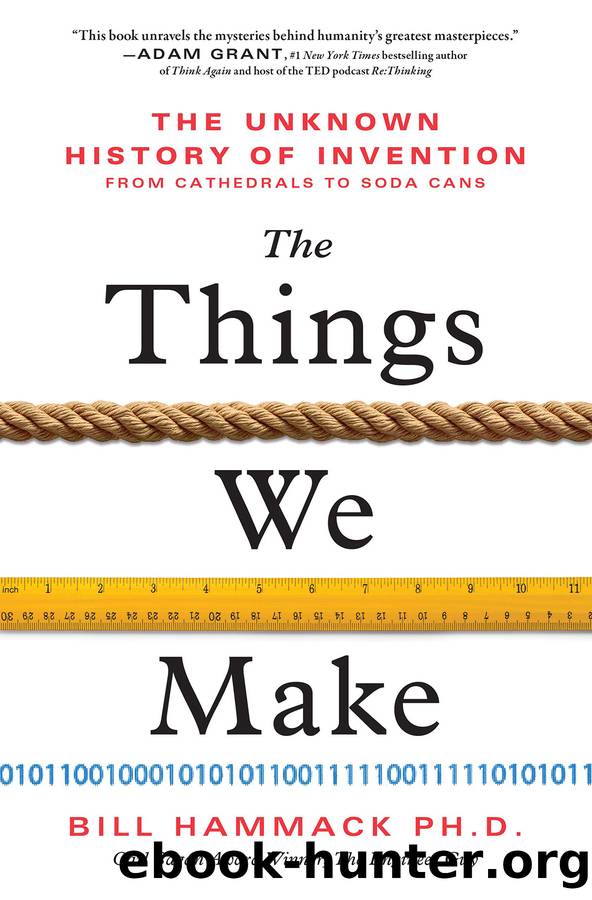The Things We Make by Bill Hammack

Author:Bill Hammack
Language: eng
Format: epub
Publisher: Sourcebooks
The second method historically didnât fare better. The earliest recorded version of the steam paddle wheel device is from 1629, when Giovanni Branca, an Italian engineer, proposed a giant boiler, shaped like a human head, that blasted a jet of steam onto a paddle wheel. When engineers built devices like Brancaâs, not only did the paddle wheel spin so fast that it blew apart, the expelled steam cut through the metal blades. It seemed that inherent in the direct transfer of steam power to circular motion was an impasse between the force of steam necessary to do useful work and the ability of a machineâs materials to withstand the relentless power of that force.
To overcome this no-win scenario, then, Parsons knew he must slow the flow rate of steam to tame the rotations and, as he put it, âavoid the well-known cutting action on metal of steam at high velocity.â11 To this problem, Parsons applied what his wife called his âoutstanding feature,â his power of concentration.12 âNothing disturbed him when he was absorbed in a problem,â she said. âNo noises, no discomfort, no time and no mealsâhe was perfectly oblivious to them all.â Indeed, Parsons, when on the scent of a solution, worked twenty-four, even thirty-six hours straight. Late at night, he sat in his study, a white-sulfur cockatoo at his side, to whom he absentmindedly fed sugar lumps. And during the day, when in this state, he walked around his machine shop with a glassy gaze. Once, he was so distracted that he stepped into a bucket of lubricating oil; another time, he stepped backward off a three-foot-high platform, struck the edge of a machine, and nearly broke his ribs. This deep thought, though, led him to his breakthrough design: Parsons realized that the high velocities that tore apart early machines occurred because the high-pressure steam was vented to the atmosphere, which causes the steam to rush out at hurricane speeds. He reasoned that if he could drop the pressure through a series of contained stepsâso no drop was too largeâhe could reduce the flow rate of the steam yet eventually extract all its energy.
Although his idea was straightforward in principle, Parsons described the practical problems of executing his design as of âalmost infinite complexityâ13âthe number of steps he should use to slowly drop the steam pressure, the speeds of rotation caused by the steamâs pressure, and the question of whether the steamâs velocity was low enough to avoid cutting steel. To find his way in this âinfinite complexity,â Parsons turned to what he had referred to as the âdata of the physicists.â14 His engineering solution would be impossible without the help of science.
In the thirty years before Parsonsâs work, the field of thermodynamicsâthe study of energy and its transformationsâblossomed thanks to two scientists who contrasted greatly in their work and their personalities and who are forgotten to all except the most dedicated historians of science. The first is the French scientist Henri-Victor Regnault, a man so famous in
Download
This site does not store any files on its server. We only index and link to content provided by other sites. Please contact the content providers to delete copyright contents if any and email us, we'll remove relevant links or contents immediately.
| American National Standards Institute (ANSI) Publications | Architecture |
| History | Measurements |
| Patents & Inventions | Research |
Whiskies Galore by Ian Buxton(41935)
Introduction to Aircraft Design (Cambridge Aerospace Series) by John P. Fielding(33085)
Small Unmanned Fixed-wing Aircraft Design by Andrew J. Keane Andras Sobester James P. Scanlan & András Sóbester & James P. Scanlan(32763)
Craft Beer for the Homebrewer by Michael Agnew(18193)
Turbulence by E. J. Noyes(7977)
The Complete Stick Figure Physics Tutorials by Allen Sarah(7334)
Kaplan MCAT General Chemistry Review by Kaplan(6896)
The Thirst by Nesbo Jo(6876)
Bad Blood by John Carreyrou(6580)
Modelling of Convective Heat and Mass Transfer in Rotating Flows by Igor V. Shevchuk(6406)
Learning SQL by Alan Beaulieu(6235)
Weapons of Math Destruction by Cathy O'Neil(6205)
Man-made Catastrophes and Risk Information Concealment by Dmitry Chernov & Didier Sornette(5951)
Digital Minimalism by Cal Newport;(5698)
Life 3.0: Being Human in the Age of Artificial Intelligence by Tegmark Max(5506)
iGen by Jean M. Twenge(5384)
Secrets of Antigravity Propulsion: Tesla, UFOs, and Classified Aerospace Technology by Ph.D. Paul A. Laviolette(5330)
Design of Trajectory Optimization Approach for Space Maneuver Vehicle Skip Entry Problems by Runqi Chai & Al Savvaris & Antonios Tsourdos & Senchun Chai(5036)
Pale Blue Dot by Carl Sagan(4949)
